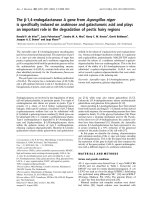Big Questions from Little People: And Simple Answers from Great Minds
Bạn đang xem bản rút gọn của tài liệu. Xem và tải ngay bản đầy đủ của tài liệu tại đây (1.97 MB, 493 trang )
BIG QUESTIONS
from Little People . . . and
Simple Answers from
GREAT MINDS
Compiled by
Gemma Elwin HarrisDEDICATION
To Evie, Rosie, Eliza and Seth
EPIGRAPH
The pursuit of truth and beauty is a sphere of
activity in which we are permitted to remain
children all our lives.
Albert Einstein
CONTENTS
Dedication
Epigraph
Editor’s note
A BIG thank you
Are there any undiscovered animals?
Is it OK to eat a worm?
What are atoms?
Why are the grown-ups in charge?
Why is blood red, not blue?
How are dreams made?
How long would it take to walk around the
world?
Why do we have music?
Do aliens exist?
Where does wind come from?
Why do we speak English?
Why did dinosaurs go extinct and not other
animals?
Why do cakes taste so nice?
How do plants and trees grow from a small seed?
Why do monkeys like bananas?
Is the human brain the most powerful thing on
earth?
What is global warming?
Why do I get hiccups?
Why is space so sparkly?
Why can’t animals talk like us?
How do story writers get ideas for characters?
How do cars work?
Why can’t I tickle myself?
Who had the first pet?
Why are planets round?
Can a bee sting a bee?
Why do we cook food?
How do you keep going when you’re losing in
sport?
Why do wars happen?
Why do we go to the toilet?
Why do lions roar?
Why do we have money?
Who wrote the first book ever?
Why do elephants have trunks?
Why are some people mean?
How do trees make the air that we breathe?
If the universe started from nothing, how did it
become something?
Why do people have different-coloured skin?
Will the North and South Poles ever melt
completely?
Where does ‘good’ come from?
Why is the Sun so hot?
What is the most endangered animal in the world?
Why do girls have babies and boys don’t?
In Victorian times why did kids do all the work?
What is gravity, and why isn’t there any in space?
Why can’t we live forever?
How does water get into the clouds so it can
rain?
Why do animals that fly have feathers, not
including bats?
How does my brain control me?
How do chefs get ideas for recipes?
Are we all related?
How do they know all snowflakes are different?
Why does time go slowly when you want it to go
fast?
Who first made metal things?
How do the bubbles get into fizzy drinks?
Why is the sky blue?
How do sportspeople concentrate when the
crowd is noisy?
Do monkeys and chickens have anything in
common?
How did we first learn to write?
Why do scientists look at germs, and why can’t I
see them?
Do any people eat polar bears or lions?
Why does the Moon change shape?
Do numbers go on forever?
Where did the first seed come from?
Why was Guy Fawkes so naughty?
What do you have to do to get into the Olympic
Games?
Who was the first artist?
What am I made of?
Why do penguins live at the South Pole but not the
North?
How does an aeroplane fly?
What’s the strongest animal?
Who named all the cities?
Why is water wet?
What would I look like if I didn’t have a
skeleton?
Are cows polluting the air?
How do writers think of their ideas?
Who invented chocolate?
Why do men grow beards and not women?
Is sugar bad for you?
How did they build the pyramids in Egypt?
Why is the sky dark at night?
What should you do when you can’t think what to
draw or paint?
How do you make electricity?
Did Alexander the Great like frogs?
What are our bones made of?
If you’re on a boat with no food or water, what
do you do?
How does my cat always find her way home?
What’s inside the world?
Who is God?
How many different types of beetle are there in
the whole world?
How far away is space?
How does lightning happen?
Why are some people taller than others?
Why is wee yellow?
What was the biggest battle the Romans fought in?
Why do I get bored?
Are there really monsters living in our mouths
called blackteria?
Why do we sleep at night?
Will we ever be able to go back in time?
How does fire get on fire?
Why do we have lots of countries, not just one big
country?
What makes me me?
If a cow didn’t fart for a whole year and then did
one big fart, would it fly into space?
Why is the sea salty?
What is the internet for?
How did Michelangelo get so famous?
How do you fall in love?
If my stomach was unravelled how long would it
be?
Why do we have an alphabet?
Why do I always fight with my brother and sister?
What are rainbows made of?
When did people start using recipes?
Why does the Moon shine?
Where do the oceans come from?
Why do snails have shells but slugs don’t?
Out-takes!
Contributors
Index
About the Author
Credits
Copyright
About the Publisher
EDITOR’S NOTE
My son is two years old and already the questions
have started. Recently he pointed at the moon as
we hurried home from nursery and asked, ‘What
dat?’ For now, ‘That’s the moon’ will do as
answer, but I know it won’t be long before I’m
struggling to explain what the moon is made of,
how far away it is, and whether a goldfish could
survive there.
The questions children ask are often baffling.
Chances are, if you ever knew the answer – or
even part of the answer – you’ve probably
forgotten it or can only remember a half-baked
version of the truth. Imagine if you could turn to a
well-known expert at this point and get them to
answer for you, in language simple enough for a
child to understand. This was the idea behind BIG
QUESTIONS.
With the help of ten elementary schools, we
asked thousands of kids between the ages of four
and twelve to send us the questions they most
wanted answered. The results were fascinating and
funny. There were cute and quirky questions, like
‘Why is space so sparkly?’, ‘Who had the first
pet?’ and ‘Can a bee sting a bee?’ Others were
fiendishly difficult: ‘How is electricity made?’ or
‘Where do oceans come from?’ And a few shot
straight to the heart of a deep philosophical
conundrum: ‘Why do we have wars?’, ‘How do
we fall in love?’ and ‘Where does good come
from?’
Among their hand-written replies we found a
lot of questions involving bodily functions. ‘Why
is wee yellow?’ seemed to be a recurring concern.
The mysteries of space clearly obsessed many
children, and it’s no surprise that animals –
chickens, cows and monkeys – popped up
frequently. There was even one question, of great
genius, that encapsulated all the above – a perfect
storm of cows, bowels and space travel: ‘If a cow
didn’t fart for a year and then did one big fart
would it fly into space?’
What would world experts say, when faced
with these questions? The response from our panel
has been staggering and heart-warming. However
busy, they’ve carved out time to co-write this book
in order to benefit the NSPCC – the UK’s leading
child protection charity.
Bear Grylls took the trouble to explain the
nutritious benefits of eating a worm. Jessica Ennis
emailed a mantra for aspiring Olympians, just two
months before the 2012 Games. Derren Brown set
his impressive grey matter to work on ‘Is the
human brain the most powerful thing on earth?’
While Philippa Gregory put her latest novel on
hold to shed light on why Guy Fawkes was ‘so
naughty’. No question was too bizarre. The
historian Bettany Hughes barely blinked when we
asked her ‘Did Alexander the Great like frogs?’
This book doesn’t claim to offer the only
answers to these questions. It’s an anthology of
voices, a personal response from each expert to a
child’s idiosyncratic question. We hope you enjoy
reading them with your family and take something
from them – including the mental image of a cow
soaring into the stratosphere powered by its own
methane. (Thanks to the science writer Mary
Roach and her friend Ray, a real life rocket
scientist, for running the maths on that one.)
When my son asked his question about the moon
that evening, I was busy making a mental list of
what we had in the fridge for dinner. Lying back in
his buggy, he was taking in the beauty of the night
sky. There above, he saw a pale and ghostly globe
shining in the darkness for the very first time. His
question ‘What dat?’ demanded I see that full moon
too. So we stopped and stared, and how strange
and new it seemed to us both.
Gemma Elwin Harris
A BIG THANK YOU
I cannot thank enough the brilliant and extremely
busy scientists, historians, philosophers,
psychologists, naturalists, explorers, artists,
musicians, authors, archaeologists and
paleontologists, sportsmen and women who took
time to answer a child’s question for this book. As
well as the much-loved comedians who wrote one-
liners for our Out-Takes chapter. It would take too
long to thank you each individually here but I’d just
like to say how much your kindness has been
appreciated by the NSPCC.
Without the enthusiastic participation of ten
schools, we’d have had no children’s questions to
ask. So a special thank you to the staff and pupils
at: Corstorphine Primary, and Mary Erskine and
Stewart’s Melville Junior School, Edinburgh;
Cleobury Mortimer Primary School, Shropshire;
Woodland Grange Primary, Leicester; Furzedown
Primary School, Tooting; Raysfield Infants’
School, Chipping Sodbury; The Mulberry Primary
School, Tottenham; Shottermill Junior School,
Haslemere; Boxgrove Primary School, Guildford;
and Grange Primary, Newham. In particular to
Gillian Lyon the deputy head at Mary Erskine and
Stewart’s Melville, Caroline Gorham, and Ed
Flanagan and Kirk Hayles at Woodland Grange
Primary for their BIG QUESTIONS assembly.
To friends whose curious offspring, nieces and
nephews got the first questions rolling in: The
Scott clan, the Wrays, the Flemings, Lucinda Greig
and extended family, Melonie Ryan, Wendy and
Alfie Carter, Cat Dean and brood, Nicole Martin,
Ben Crewe and Ruby, Esther and Hannah Davis.
For ideas, advice and introductions: Yana Peel
of Outset UK, Joe Galliano, Simon Prosser, Jamie
Byng, Marcus Chown, Duncan Copp, Chris Riley,
Richard Holloway, Justin Pollard, Roger
Highfield, Chris Stringer, and Giles Morgan at
HSBC sponsorship. Not forgetting dear friends
Gus Brown, Sally Howard, Amy Flanagan, Ngayu
Thairu, Chris Hale, Catherine and Ralph Cator,
Bex and Adam Balon, and my sisters Sophie and
Lucinda whose encouragement, contacts and
science-brains I’d have been lost without.
I’m grateful to those patient agents who went
above and beyond: Jo Sarsby, Nelle Andrew, Sue
Rider and Sophie Kingston-Smith, Stephen at
Michael Vine Associates, Catherine Clarke,
Caroline Dawnay, Hannah Chambers and Vivienne
Clore.
A heartfelt thank you to my own agent Gordon
Wise at Curtis Brown and to my editor Hannah
Griffiths for embracing the project straight off and
devoting careful thought and creativity to it ever
since. To the team at Faber & Faber: Lucie Ewin,
Donna Payne, Sarah Christie; and our illustrator
Andy Smith. Also to Kristine Dahl at ICM and
Hilary Redmon at Ecco, HarperCollins, for their
commitment and vote of confidence from across
the pond. Everyone involved in BIG
QUESTIONS is massively excited to be taking it
to the US.
Which brings me to the sparky teams at the
NSPCC. My respect and admiration goes out to
you and I hope the proceeds from this book go
some way to supporting the vital work you do
every day. Charly Meehan, Viola Carney, Stefan
Souppouris, Helen Carpenter, Lucie Sitch, Sarah
Dade, Dan Brett-Schneider and the Fundraising
Communications Team – you’ve been fantastic to
work with.
Finally, love and thanks to my gorgeous
husband, Nick. It would take a book to list the
reasons why.
ARE THERE ANY
UNDISCOVERED
ANIMALS?
Sir David Attenborough
naturalist
Yes. Hundreds. Probably thousands. Exactly how
many no one can say – because they have not yet
been discovered.
If you spent a day in a tropical rainforest,
swishing a butterfly net around through the
undergrowth or the leaves high in the tree canopy,
you would certainly collect hundreds of insects.
Many of them would be beetles. Would any of
them be unknown to science? You would have to
ask a beetle scientist. Many he would recognise
straight away. But there might be a few that would
puzzle him.
Would they be new species? It might take him a
long time in a museum, examining them and
comparing them with others in the museum or
pictured in books about beetles, to be quite certain
that he had a new species. But there would
probably be one. In fact, I suspect it might be
harder to find a beetle scientist who would be able
to do this very difficult work than to find an
unknown beetle.
Unknown big animals are certainly much rarer.
Your best chance of finding one would be to go to
the least explored part of our planet – the very
deep sea. You can only go down there in special
deep-sea submarines. They have to be extremely
strong to withstand the huge pressure of the water.
And of course it is pitch black down there, so you
would have to have powerful lights to do your
searching.
You might get a glimpse of something in their
beams, but unless you could catch it and examine it
in detail, you could not be certain that it was a new
species. And catching animals down there is a very
difficult job, needing very specialised equipment.
But I am sure there are still monsters down there
that no one has ever seen before.









